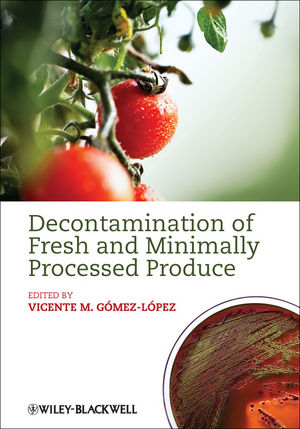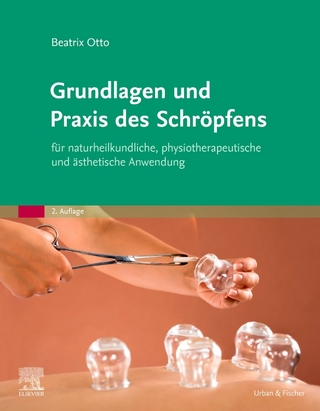
Decontamination of Fresh and Minimally Processed Produce
Wiley-Blackwell (Verlag)
978-0-8138-2384-3 (ISBN)
- Titel z.Zt. nicht lieferbar
- Versandkostenfrei
- Auch auf Rechnung
- Artikel merken
The many methods and effects of decontamination are detailed, enabling industry professionals to understand the available state-of-the-art methods and select the most suitable approach for their purposes. The book serves as a compendium of information for food researchers and students of pre- and postharvest technology, food microbiology and food technology in general. The structure of the book allows easy comparisons among methods, and searching information by microorganism, produce, and quality traits.
Dr. Vicente M. Gómez-López is a Senior Researcher at the Centro de Edafología y Biología Aplicada del Segura (CEBAS-CSIC, Murcia, Spain) and a former Associate Professor at the Instituto de Ciencia y Tecnología de Alimentos, Facultad de Ciencias, Universidad Central de Venezuela
Preface xvii List of Contributors xix
SECTION I PRODUCE CONTAMINATION 1
1 Microbial ecology 3
Marilyn C. Erickson
1.1 Introduction 3
1.2 Sources of preharvest contamination 4
1.3 Fate of pathogen contamination in plant production systems 12
1.3.1 Experimental studies – field studies versus growth chamber studies 12
1.3.2 Rhizosphere and bulk soil systems 16
1.3.3 Phyllosphere 22
1.4 Molecular and biochemical responses of enteric pathogens and plant hosts 27
1.4.1 Mechanisms employed by enteric pathogens to survive as plant endophytes or epiphytes 27
1.4.2 Mechanisms employed by plant hosts to resist invasion by enteric pathogens 27
1.5 Cross-contamination of enteric pathogens to produce during harvest 28
1.6 Concluding comments 29
References 29
2 Surface characteristics of fresh produce and their impact on attachment and removal of human pathogens on produce surfaces 43
Hua Wang, Bin Zhou, and Hao Feng
2.1 Introduction 43
2.2 Produce surface characteristics 44
2.2.1 Surface topography 44
2.2.2 Surface hydrophobicity 46
2.3 Means to determine produce surface characteristics 47
2.3.1 Determination of surface roughness 47
2.3.2 Surface roughness determination with CLSM 48
2.3.3 Determination of hydrophobicity 51
2.4 Effect of surface characteristics on attachment and removal of human pathogens 51
2.4.1 Effect of surface roughness 51
2.4.2 Effect of hydrophobicity 54
2.4.3 Effect of hydrodynamics 55
References 55
3 Biofilms 59
Shin-Hee Kim and Cheng-i Wei
3.1 Introduction 59
3.2 Biofilm formation 60
3.3 Presence of biofilms on the produce surface 66
3.4 Antimicrobial resistance of biofilms versus planktonic cells 68
3.5 Perspective 71
References 71
4 Resistance and sublethal damage 77
Pascal Delaquis and Susan Bach
4.1 Introduction 77
4.2 Basic concepts 78
4.2.1 Definitions 78
4.2.2 Chemical interventions used in the produce industry 78
4.2.3 Physical interventions used in the produce industry 79
4.2.4 Mode of action of biocides, food antimicrobials, and physical treatments 79
4.3 Stress and resistance to biocides and antimicrobial physical treatments 81
4.4 Implications of stress, resistance, and sublethal damage in fresh produce decontamination 83
References 84
SECTION II DECONTAMINANTS 87
5 Produce washers 89
Steven Pao, Wilbert Long III, Chyer Kim, and D. Frank Kelsey
5.1 Basic concepts 89
5.2 Types of washers 91
5.2.1 Immersion washers 92
5.2.2 Non-immersion washers 95
5.3 Factors influencing the efficacy of washing 97
5.3.1 Time of contamination 98
5.3.2 Sanitation practices 98
5.3.3 Water quality 99
5.3.4 Surfactants and antimicrobials 99
5.3.5 Pathogen internalization 100
5.4 Conclusion 100
Acknowledgment 101
References 101
6 Minimal processing 105
Maria I. Gil and Ana Allende
6.1 Introduction 105
6.2 Effect of minimal processing on pathogenic bacteria 106
6.3 Effect of minimal processing on spoilage bacteria 108
6.4 Effect of minimal processing on vegetable physiology 110
6.5 Effect of minimal processing on quality and shelf life 113
6.6 Effect of minimal processing on nutritional and phytochemical composition 114
6.7 Conclusion 115
References 116
7 Chlorine 121
Cristóbal Chaidez, Nohelia Castro-del Campo, J. Basilio Heredia, Laura Contreras-Angulo, Gustavo González–Aguilar, and J. Fernando Ayala–Zavala
7.1 Definition 121
7.2 Inactivation mechanism 122
7.3 Effect of chlorine on pathogenic microorganisms 123
7.4 Effect of chlorine on spoilage microorganisms and shelf life 125
7.5 Effect of chlorine on vegetable physiology 125
7.6 Effect of chlorine on sensory quality 127
7.7 Effect of chlorine on nutritional and phytochemical composition 127
7.8 Chlorine residues and formation of toxic by-products 128
7.9 Regulatory status 129
References 131
8 Electrolyzed oxidizing water 135
Muhammad Imran Al-Haq and Vicente M. Gómez-López
8.1 Definition 135
8.2 Generation devices 138
8.3 Inactivation mechanism and factors affecting EO efficacy 142
8.4 Effect of EO water on pathogenic microorganisms 153
8.5 Effect of EO water on spoilage microorganisms and shelf life 153
8.6 Effects of EO water on vegetable physiology 154
8.7 Effect of EO water on sensory quality 155
8.8 Effect of EO water on nutritional and phytochemical composition 156
8.9 Residues and formation of toxic by-products 156
8.10 Regulatory status 157
References 157
9 Chlorine dioxide 165
Vicente M. Gómez-López
9.1 Definition and generalities 165
9.2 Inactivation mechanism 166
9.3 Effect of chlorine dioxide on pathogenic microorganisms 167
9.4 Spoilage and shelf life 169
9.5 Sensory quality 170
9.6 Effect of chlorine dioxide on vegetable physiology 171
9.7 Effect of chlorine dioxide on nutritional and phytochemical composition 171
9.8 Residues and toxic by-products 171
9.9 Legal framework 172
References 172
10 Ozone 177
Hülya Ölmez
10.1 Definition 177
10.2 Generation devices 178
10.3 Inactivation mechanism 179
10.4 Effect of ozone on pathogenic microorganisms 181
10.5 Effect of ozone on spoilage microorganisms and shelf life 185
10.6 Effect of ozone on vegetable physiology 185
10.7 Effect of ozone on sensory quality 187
10.8 Effect of ozone on nutritional and phytochemical composition 188
10.9 Ozone residues and formation of toxic by-products 188
10.10 Regulatory status 191
References 191
11 Hydrogen peroxide 197
Dike O. Ukuku, Latiful Bari, and Shinichi Kawamoto
11.1 Introduction 197
11.2 Definition of hydrogen peroxide 198
11.3 Inactivation mechanism 198
11.4 Effect of hydrogen peroxide on pathogenic microorganisms 201
11.5 Effect of hydrogen peroxide on spoilage microorganisms and shelf life 203
11.6 Effect of hydrogen peroxide on vegetable physiology 206
11.7 Effect of hydrogen peroxide on sensory quality 207
11.8 Effect of hydrogen peroxide on nutritional and phytochemical composition 209
11.9 Effect of hydrogen peroxide on residues and formation of toxic by-products 211
References 212
12 Peroxyacetic acid 215
Gustavo González-Aguilar, J. Fernando Ayala-Zavala, Cristóbal Chaidez-Quiroz, J. Basilio Heredia, and Nohelia Castro-del Campo
12.1 Definition 215
12.2 Inactivation mechanism 216
12.3 Effect of PAA on pathogenic microorganisms 217
12.4 Effect of PAA on spoilage microorganisms and shelf life 218
12.5 Effect of PAA on vegetable physiology 219
12.6 Effect of PAA on sensory quality 219
12.7 Effect of PAA on nutritional and phytochemical composition 220
12.8 PAA residues and formation of toxic by-products 220
12.9 Regulatory status 221
References 221
13 Essential oils for the treatment of fruit and vegetables 225
Catherine Barry-Ryan and Paula Bourke
13.1 Introduction to essential oils 225
13.1.1 Decontamination in the fruit and vegetable industry 225
13.1.2 Definition of essential oils 226
13.2 Inactivation mechanism of essential oils 226
13.2.1 The mechanisms of action of essential oils 226
13.2.2 Effect of essential oil profile on mechanism of action 228
13.2.3 Other factors that affect the mechanism of action of essential oils 229
13.3 Effect of essential oils on microorganisms 230
13.3.1 Effect of essential oils on pathogenic microorganisms 230
13.3.2 Effect of essential oils on spoilage microorganisms 231
13.3.3 Effect of essential oils on Gram-positive versus Gram-negative microorganisms 232
13.3.4 Effect of specific essential oils on microorganisms 233
13.4 Effect of essential oils on fruit and vegetable physiology 235
13.5 Effect of essential oils on sensory quality 235
13.6 Effect of essential oils on nutritional and phytochemical composition 237
13.7 Toxicity of essential oils 238
13.8 Regulatory status of essential oils 239
References 239
14 Edible fi lms and coatings 247
María Alejandra Rojas-Graü, Laura Salvia-Trujillo, Robert Soliva-Fortuny, and Olga Martín-Belloso
14.1 Definition 247
14.2 Composition and application of edible films and coatings 248
14.3 Edible films and coatings as antimicrobials 251
14.3.1 Edible films and coatings with antimicrobial properties 251
14.3.2 Antimicrobial agents incorporated into edible films and coatings 252
14.3.3 Methods to evaluate effectiveness of antimicrobial films and coatings 258
14.3.4 Effect of edible coatings on pathogenic microorganisms 259
14.3.5 Effect of edible coatings on microbial spoilage and shelf life 260
14.4 Effect of edible coatings on vegetable physiology 263
14.5 Effect of edible coatings on sensory quality 265
14.6 Effect of edible coatings on nutritional aspects 266
14.7 Toxicity 266
14.8 Regulatory status 267
References 267
15 Miscellaneous decontaminants 277
Vicente M. Gómez-López
15.1 Introduction 277
15.2 Acidified sodium chlorite 278
15.3 Lactic acid 279
15.4 Calcinated calcium 280
15.5 Levulinic acid 280
15.6 Benzalkonium chloride 280
References 281
SECTION III BIOLOGICAL DECONTAMINATION STRATEGIES 283
16 Bacteriophages 285
Manan Sharma and Govind C. Sharma
16.1 Introduction 285
16.2 Inactivation mechanism 286
16.3 Effect of bacteriophages on pathogenic microorganisms 288
16.3.1 Lytic bacteriophages and leafy greens 289
16.3.2 Lytic bacteriophages and tomatoes 290
16.3.3 Lytic bacteriophages and sprouts 290
16.3.4 Lytic bacteriophages and melons 291
16.3.5 Lytic bacteriophages and apples 291
16.3.6 Lytic bacteriophages and hard surfaces 292
16.4 Risks to human health 293
16.5 Regulatory status 293
16.6 Conclusions 294
References 294
17 Protective cultures 297
Antonio Gálvez, Rubén Pérez Pulido, Hikmate Abriouel, Nabil Ben Omar, and María José Grande Burgos
17.1 Basic concepts 297
17.2 Effect of protective cultures on pathogenic microorganisms 298
17.3 Effect of protective cultures on spoilage microorganisms and shelf life 305
17.4 Effect of protective cultures on sensory quality and nutritional and phytochemical composition 309
17.5 Risks to health 310
17.6 Regulatory status 311
References 312
18 Bacteriocins 317
Antonio Gálvez, Rosario Lucas, Hikmate Abriouel, María José Grande Burgos, and Rubén Pérez Pulido
18.1 Definition 317
18.2 Inactivation mechanism 318
18.3 Effect of bacteriocins on pathogenic microorganisms 319
18.4 Effect of bacteriocins on spoilage microorganisms and shelf life 323
18.5 Effect of bacteriocins on sensory quality and nutritional and phytochemical composition 324
18.6 Toxicity 325
18.7 Regulatory status 327
References 328
19 Quorum sensing 333
María S. Medina-Martínez and María Angélica Santana
19.1 Introduction 333
19.2 Quorum sensing: basic concepts 334
19.3 Quorum sensing and vegetable spoilage 336
19.4 Quorum sensing and biofilm formation 337
19.5 Quorum sensing interference and food industry 338
References 341
SECTION IV PHYSICAL METHODS 345
20 The use of mild heat treatment for fruit and vegetable processing 347
Catherine Barry-Ryan
20.1 Introduction to the use of mild heat treatment for fruit and vegetable processing 347
20.2 Definition of heat treatment 348
20.3 Mechanism of action of heat treatment 349
20.4 Effect of mild heat treatment on microorganisms 349
20.5 Effect of mild heat treatment on fruit and vegetable physiology 350
20.5.1 The responses of plant tissue to heat treatment 350
20.5.2 Effect of mild heat treatment on respiration and ethylene production 351
20.5.3 Effect of mild heat treatment on quality 352
20.5.4 Effect of mild heat treatment on weight loss 353
20.6 Effect of mild heat treatment on fruit and vegetable sensory quality 353
20.6.1 Effect of mild heat treatment on texture 353
20.6.2 Effect of mild heat treatment on color 354
20.6.3 Effect of mild heat treatment on other sensory characteristics 356
20.7 Effect of mild heat treatment on nutritional and phytochemical composition of fruit and vegetables 357
20.8 Safety and implications of heat treatment 357
References 358
21 Continuous UV-C light 365
Vicente M. Gómez-López
21.1 Definition 365
21.2 Inactivation mechanism 366
21.3 Effect of continuous UV light on pathogenic microorganisms 367
21.4 Effect of continuous UV light on spoilage microorganisms and shelf life 368
21.5 Effect of continuous UV light on vegetable physiology 369
21.6 Effect of continuous UV light on sensory quality 370
21.7 Effect of continuous UV-C light on nutritional and phytochemical composition 372
21.8 Toxicity 374
21.9 Regulatory status 375
References 375
22 Ionizing radiation 379
Xuetong Fan
22.1 Definition 379
22.2 Inactivation mechanism 380
22.3 Effect of ionizing radiation on pathogenic microorganisms 381
22.4 Effect of ionizing radiation on spoilage microorganisms and shelf life 385
22.5 Effect of ionizing radiation on physiology 386
22.5.1 Ethylene production and respiration 386
22.5.2 Enzymes involved in tissue browning 388
22.5.3 Enzymes involved in tissue softening 389
22.5.4 Other enzymes 389
22.6 Effects of ionizing radiation on sensory quality 390
22.6.1 Reduction of losses in quality 392
22.7 Effect of ionizing radiation on nutritional and phytochemical composition 392
22.7.1 Vitamin C 395
22.8 Toxicity 396
22.9 Regulatory status 397
Disclaimer 398
References 398
23 Miscellaneous physical methods 407
Vicente M. Gómez-López
23.1 Introduction 407
23.2 Pulsed light 407
23.3 Photosensitization 409
23.4 Low-temperature plasma 409
23.5 Steamer jet injection 411
23.6 Radio-frequency heating 412
23.7 Vacuum–steam–vacuum 412
23.8 Power ultrasound 413
References 414
24 Hurdle technology principles applied in decontamination of whole and fresh-cut produce 417
María S. Tapia and Jorge Welti-Chanes
24.1 Introduction 417
24.2 Mild technologies: whole and fresh-cut hurdles: Summing up steps for decontamination 419
24.3 “All that washing”: Washing and sanitizing treatments for the produce industry 420
24.4 To kill or not to kill: Safety without having a true kill step 434
24.5 Combination of whole and fresh-cut hurdles 439
24.6 Final remarks 442
Acknowledgments 443
References 443
SECTION V STORAGE STRATEGIES 451
25 Modified atmosphere packaging 453
Matteo Alessandro Del Nobile, Amalia Conte, Marianna Mastromatteo, and Marcella Mastromatteo
25.1 Basic concepts 453
25.2 Relevant case studies of passive and active MAP 457
25.2.1 Vegetables 457
25.2.2 Fruit 459
25.3 Mathematical models to optimize headspace conditions for packaging minimally processed food 460
25.3.1 Steady-state conditions 461
25.3.2 Transient conditions 462
References 463
26 Cold chain 469
Pramod V. Mahajan and Jesus Frías
26.1 Introduction 469
26.2 Cold chain 470
26.3 Sustainability of the cold chain 470
26.4 Cold chain and safety 471
26.5 Cold chain framework 472
26.6 Cold chain and quality 473
26.7 The cold chain and fresh produce distribution 474
26.7.1 Precooling 475
26.7.2 Convective-air and evaporative cooling 475
26.7.3 Contact or package icing 476
26.7.4 Hydrocooling 476
26.7.5 Forced-air cooling 476
26.7.6 Vacuum cooling 476
26.7.7 Cryogenic cooling 477
26.7.8 Freeze chilling 477
26.8 Transportation 477
26.9 Retail display 477
26.10 Compliance in the cold chain 478
26.11 Monitoring the cold chain 479
26.11.1 The use of sensors in cold chain assessment 479
26.12 Cold chain assessment 481
Acknowledgment 482
References 482
SECTION VI MODELING TOOLS 485
27 Modeling microbial responses during decontamination processes 487
Eva Van Derlinden, Astrid M. Cappuyns, Laurence Mertens, Jan F. Van Impe, and Vasilis P. Valdramidis
27.1 Introduction 487
27.2 Experiment design 488
27.2.1 Design of experiments (DOE) 489
27.2.2 Optimal experiment design for parameter estimation (OED/PE) 491
27.2.3 Implementations of OED/PE for microbial inactivation modeling 493
27.3 Model structure (selection) 494
27.3.1 Kinetic modeling 495
27.3.2 Probabilistic modeling 507
27.3.3 Dose–response modeling 509
27.3.4 Parameter estimation 513
27.4 Model validation 514
27.4.1 Model validation data 515
27.4.2 Graphical model structure and performance evaluation 515
27.4.3 Quantitative model structure and performance evaluation 516
27.5 Conclusions 519
References 519
28 Modeling microbial growth 529
Milena Sinigaglia, Maria Rosaria Corbo, and Antonio Bevilacqua
28.1 Introduction 529
28.2 Logistic model 532
28.3 Gompertz equation 532
28.4 Baranyi equation 533
28.5 Shelf life evaluation: the classical approach 535
28.6 The stability time 536
28.7 The risk time 537
28.8 Mathematical modeling: some key limitations 537
References 538
Index 541
| Erscheint lt. Verlag | 1.5.2012 |
|---|---|
| Verlagsort | Hoboken |
| Sprache | englisch |
| Maße | 178 x 252 mm |
| Gewicht | 1153 g |
| Themenwelt | Sachbuch/Ratgeber ► Gesundheit / Leben / Psychologie |
| Technik ► Lebensmitteltechnologie | |
| Weitere Fachgebiete ► Land- / Forstwirtschaft / Fischerei | |
| ISBN-10 | 0-8138-2384-6 / 0813823846 |
| ISBN-13 | 978-0-8138-2384-3 / 9780813823843 |
| Zustand | Neuware |
| Haben Sie eine Frage zum Produkt? |
aus dem Bereich


